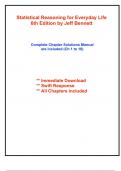Statistical Reasoning for Everyday Life
6th Edition by Jeff Bennett
Complete Chapter Solutions Manual
are included (Ch 1 to 10)
** Immediate Download
** Swift Response
** All Chapters included
,Table of Contents are given below
1. Speaking of Statistics
2. Measurement in Statistics
3. Visual Displays of Data
4. Describing Data
5. A Normal World
6. Probability in Statistics
7. Correlation and Causality
8. Inferences from Samples to Populations
9. Hypothesis Testing
10. t Tests, Two-Way Tables, and ANOVA
,Solutions Manual organized in reverse order, with the last chapter
displayed first, to ensure that all chapters are included in this document.
(Complete Chapters included Ch10-1)
Section 10.1: The t Distribution for Inferences about a Mean 119
Chapter 10: Additional Topics in Inferential Statistics
Section 10.1: The t Distribution for Inferences about a Mean
1. The t distribution is a distribution that is quite similar to the normal distribution; its precise shape depends on
the sample size as well as on the sample mean and standard deviation. We can use the t distribution when the
population standard deviation is not known and the population is normally distributed, or when the population
standard deviation is not known and the sample size is greater than 30. The advantages of the t distribution are
that calculations can be done without knowing the population standard deviation and that the t distribution
accounts for the greater variability that arises with small sample sizes.
2. The number of degrees of freedom is n 1, which is the sample size minus 1. The number of degrees of
freedom is used to find the critical t values, which are used for constructing confidence intervals and testing
claims made about population means.
3. The margin of error is E (t s) n . The fundamental difference is that the formula for the margin of error
from Section 8.2 used 1.96 instead of t; the value 1.96 is from the normal distribution, whereas the value of t is
from the t distribution. The use of t yields better results because the t distribution is based on the sample size
instead of using the same constant of 1.96.
4. Use of the normal distribution requires that we know the value of the population standard deviation, , but
that value is almost never known, so the t distribution is used much more often.
5. This statement does not make sense. This would be the case only if you also know (or can safely assume) that
the population is normally distributed and the population standard deviation is unknown.
6. This statement does not make sense. In reality, the population standard deviation is almost never known, so the
t distribution should be used.
7. This statement makes sense. Because the population is not normally distributed, the conditions for using the t
distribution require a sample size greater than 30.
8. This statement makes sense. The sample size is greater than 30, so use of the t distribution provides a
reasonable estimate of the population mean.
Concepts and applications
9. The number of degrees of freedom is n 1 16 1 15. From Table 10.1, the critical value is t 2.131.
t s 2.131 10
The margin of error is E 5.3. The 95% confidence interval is x E 130 5.3 124.7
n 16
to x E 130 5.3 135.3, or 124.7 135.3.
10. The number of degrees of freedom is n 1 16 1 15. From Table 10.1, the critical value is t 2.131.
t s 2.131 3.50
The margin of error is E 1.9 inches. The 95% confidence interval is
n 16
x E 77.9 1.9 76.0 inches to x E 77.9 1.9 79.8 inches, or 76.0 inches 79.8 inches.
11. The number of degrees of freedom is n 1 35 1 34. From Table 10.1, the critical value is t 2.032.
t s 2.032 0.7
The margin of error is E 0.2 inch. The 95% confidence interval is
n 35
x E 14.5 0.2 14.3 inches to x E 14.5 0.2 14.7 inches, or 14.3 inches 14.7 inches.
12. The number of degrees of freedom is n 1 51 1 50. From Table 10.1, the critical value is t 2.009.
t s 2.009 5.013
The margin of error is E 1.410 km. The 95% confidence interval is
n 51
x E 9.808 1.410 8.398 km to x E 9.808 1.410 11.218 km, or 8.398 km 11.218 km.
, 120 Chapter 10: Additional Topics in Inferential Statistics
13. a) The number of degrees of freedom is n 1 20 1 19. From Table 10.1, the critical value is t 2.093.
t s 2.093 5629
The margin of error is E $2634. The 95% confidence interval is
n 20
x E 9004 2634 $6370 to x E 9004 2634 $11, 638, or $6370 $11, 638.
b) Use the upper confidence limit of $11,638 as the worst possible hospital cost to the insurance company. One
could be even more conservative by using a 99% confidence interval (which would be wider). The upper
confidence limit would be higher yet.
14. a) The number of degrees of freedom is n 1 31 1 30. From Table 10.1, the critical value is t 2.042.
t s 2.042 3.704
The margin of error is E 1.358F. The 95% confidence interval is
n 31
x E 0.419 1.358 1.777F to x E 0.419 1.358 0.939F, or 1.777F 0.939F.
b) Yes, the confidence interval includes zero. This means that zero degrees is a possible value of the mean of
the differences between the actual and forecast values. We cannot claim that the three-day forecast high
temperatures tend to be different from the actual high temperatures based simply on the sample mean.
15. a) The sample mean is x 0.121 gram/mile and the sample standard deviation is s 0.0389 gram/mile. The
number of degrees of freedom is n 1 7 1 6. From Table 10.1, the critical value is t 2.447.
t s 2.447 0.0389
The margin of error is E 0.036 gram/mile. The 95% confidence interval is
n 7
x E 0.121 0.036 0.085 gram/mile to x E 0.121 0.036 0.157 gram/mile, or
0.085 gram/mile 0.157 gram/mile.
b) No, the claim does not appear to be valid. Because 0.165 gram/mile is not included in the confidence
interval, that value does not appear to be the mean.
16. a) The sample mean is x 121.75 minutes and the sample standard deviation is s 20.356 minutes. The
number of degrees of freedom is n 1 12 1 11. From Table 10.1, the critical value is t 2.201. The
t s 2.201 20.356
margin of error is E 12.93 minutes. The 95% confidence interval is
n 12
x E 121.75 12.93 108.8 minutes to x E 121.75 12.93 134.7 minutes, or
108.8 minutes 134.7 minutes.
b) No, it is not reasonable. The data and the confidence interval suggest that some movies run longer than 130
minutes.
17. The sample mean is x 1130.2 cm3 and the sample standard deviation is s 117.4 cm3. The number of
degrees of freedom is n 1 10 1 9. From Table 10.1, the critical value is t 2.262. The margin of error is
t s 2.262 117.4
E 84.0 cm3. The 95% confidence interval is x E 1130.2 84.0 1046.2 cm3 to
n 10
x E 1130.2 84.0 1214.2 cm3, or 1046.2 cm3 1214.2 cm3. Yes, the sample values appear to be
typical because they are all between 950 cm3 and 1800 cm3.
18. The sample mean is x 0.938 W/kg and the sample standard deviation is s 0.423 W/kg.
The number of degrees of freedom is n 1 11 1 10. From Table 10.1, the critical value is t 2.228.
t s 2.228 0.423
The margin of error is E 0.284 W/kg.
n 11
The 95% confidence interval is x E 0.938 0.284 0.654 W/kg to x E 0.938 0.284 1.222 W/kg, or
0.654 W/kg 1.222 W/kg. Because the values in the confidence interval are all below 1.6 W/kg, it
appears that the mean amount of cell phone radiation is less than the FCC standard, but there could be
individual cell phones that exceed that standard.





